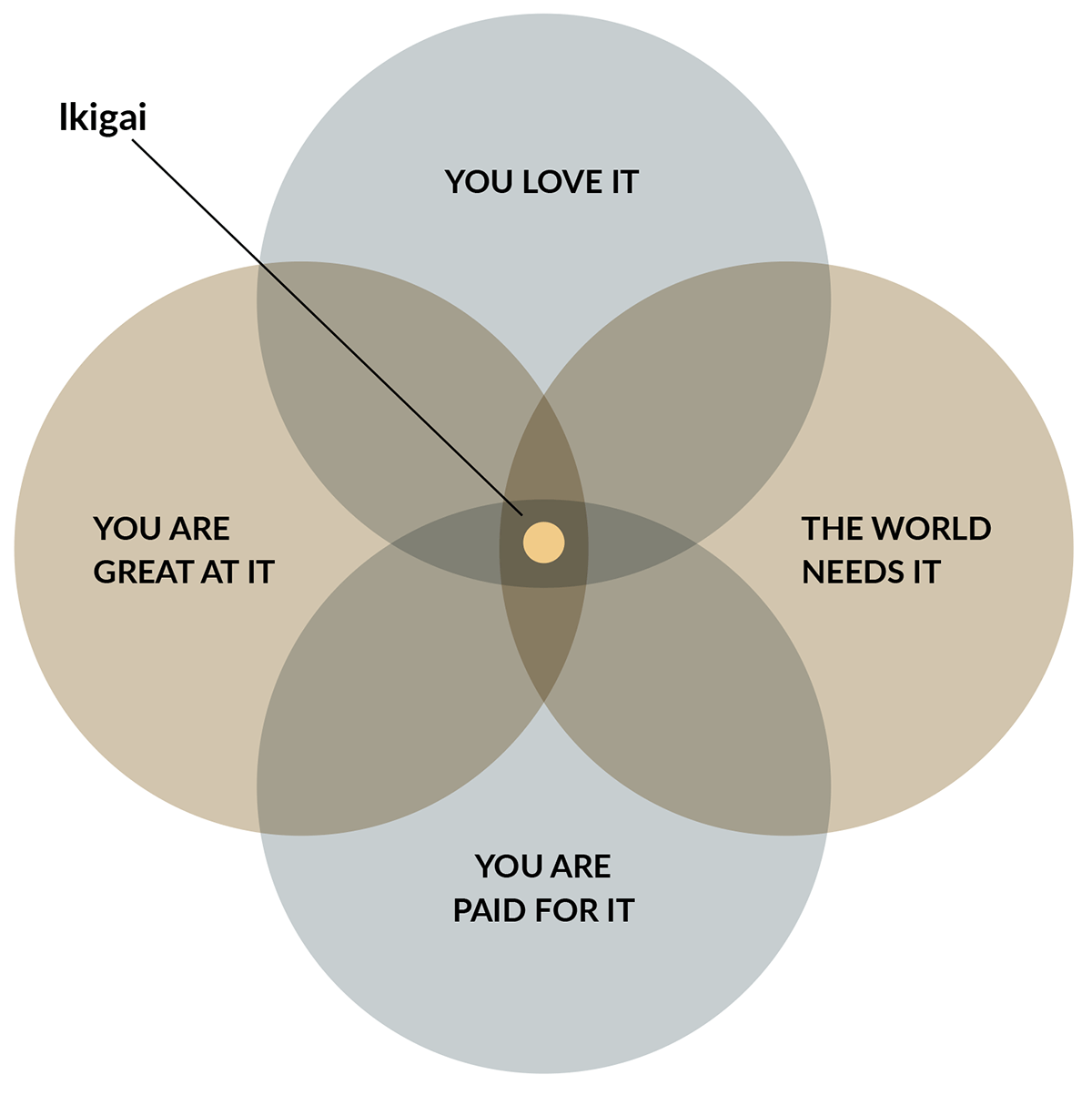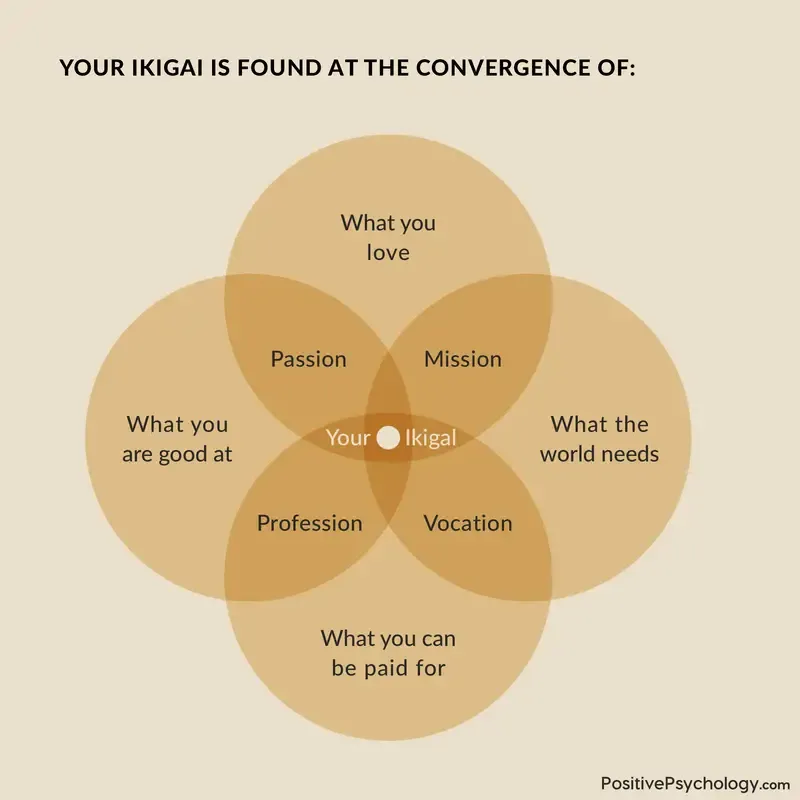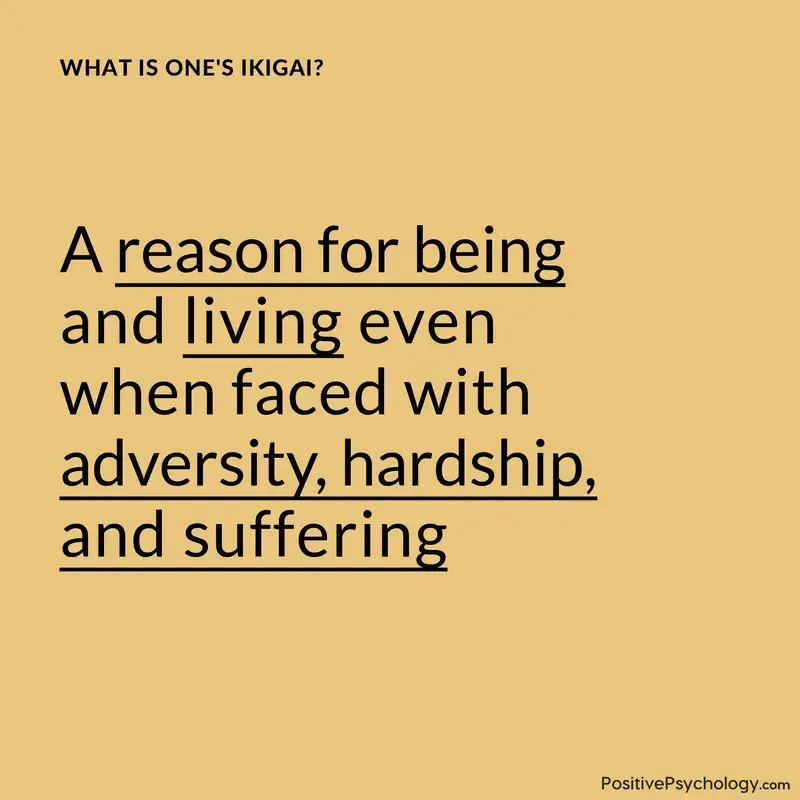The Philosophy of Ikigai: 3 Examples About Finding Purpose
 Ikigai (ee-key-guy) is a Japanese concept that combines the terms iki, meaning “alive” or “life,” and gai, meaning “benefit” or “worth.”
Ikigai (ee-key-guy) is a Japanese concept that combines the terms iki, meaning “alive” or “life,” and gai, meaning “benefit” or “worth.”
When combined, these terms mean that which gives your life worth, meaning, or purpose.
Ikigai is similar to the French term “raison d’etre” or “reason for being.”
In this article, we will delve deeper into the definition of ikigai and the philosophy behind it. We will also share an excellent tool for you to find your own ikigai and provide you with notable examples of people who actively lived out their ‘reason for being.’
Before you continue, we thought you might like to download our free Ikigai Exercise. This detailed and beautifully designed printable worksheet will walk you or your clients through the process of finding Ikigai.
This Article Contains:
What Is the Japanese Concept Ikigai?
The concept of ikigai is said to have evolved from the basic health and wellness principles of traditional Japanese medicine. This medical tradition holds that physical wellbeing is affected by one’s mental–emotional health and sense of purpose in life.
Japanese psychologist Michiko Kumano (2017) has said that ikigai is a state of wellbeing that arises from devotion to activities one enjoys, which also brings a sense of fulfillment.
Michiko further distinguishes ikigai from transitory pleasure (hedonia, in the ancient Greek sense) and aligns it with eudaimonia – the ancient Greek sense of a life well lived, leading to the highest and most lasting form of happiness.
Ikigai also resonates with Cognitive–Behavioral Therapy’s emphasis on pursuing activities that produce enjoyment and a sense of mastery, specifically as a way to alleviate depressive disorder.
Ken Mogi, a neuroscientist and author of Awakening Your Ikigai (2018, p. 3), says that ikigai is an ancient and familiar concept for the Japanese, which can be translated simply as “a reason to get up in the morning” or, more poetically, “waking up to joy.”
Ikigai also appears related to the concept of flow, as described in the work of Hungarian–American psychologist Mihaly Csikszentmihalyi. For Csikszentmihalyi, flow occurs when you are in your “zone,” as they say of high-performing athletes.
Flow is a string of “best moments” or moments when we are at our best. These best moments “usually occur when a person’s body or mind is stretched to its limit, in a voluntary effort to accomplish something difficult and worthwhile” (Csikszentmihalyi, 1990).
Flow can be said to occur when you are consistently doing something you love and that you are good at, with the possible added benefit of bringing value to others’ lives. In such a case, flow might be seen as in tune with your ikigai, or activities that give your life meaning and purpose.
It is important to note that ikigai does not typically refer only to one’s personal purpose and fulfillment in life, without regard to others or society at large.
Although it has had some historical shifts in meaning, ikigai has usually been cited as both a personal pursuit and one of benefit to others. In the end, ikigai brings meaning, purpose, and fulfillment to your life, while also contributing to the good of others.
Further, it is said that everyone has an ikigai – their particular intersection of passion, talent, and potential to benefit others. It is only a matter of finding it. The journey to ikigai might require time, deep self-reflection, and effort, but it is one we can all make.
The concept of ikigai as a purpose in life with both personal and social dimensions is captured by the well-known ikigai diagram. This diagram includes overlapping spheres covering:
- What you love
- What you are good at
- What the world needs
- What you can get paid for
The Ikigai Diagram: A Philosophical Perspective
Adapted from PositivePsychology.com’s Toolkit, 2020
As this diagram shows, ikigai holds the central position and involves four major spheres of interest and how they might overlap in one’s life. In trying to determine your own personal ikigai with the help of such a diagram, you would fill in each sphere with its appropriate content based on your own experiences, self-knowledge, and understanding of the world.
Some of the content that would go into these spheres might come easily to you. Other content might take more time and self-reflection. In any case, filling in such a diagram can help clarify where you stand in your search for ikigai and how to make any needed adjustments to attain this sometimes elusive way of being.
You Love It
This sphere includes what we do or experience that brings us the most joy in life and makes us feel most alive and fulfilled. What we love in this sense might be sailing, writing poetry, rock climbing, singing in a rock band, reading historical novels, spending leisure time with friends, etc.
What is important is that we allow ourselves to think deeply about what we love, without any concern for whether we are good at it, whether the world needs it, or if we can get paid for doing it.
You Are Great at It
This sphere includes anything you are particularly good at, such as skills you’ve learned, hobbies you’ve pursued, talents you’ve shown since an early age, etc. What you are good at might be, for example, playing the piano, being empathic, public speaking, sports, brain surgery, or painting portraits.
This sphere encompasses talents or capabilities, whether or not you are passionate about them, whether the world needs them, or if you can get paid for them.
The World Needs It
The “world” here might be humanity as a whole, a small community you are in touch with, or anything in between. What the world needs might be based on your impressions or needs expressed by others. The world’s needs might include skilled nursing, clean water, home heating, election day volunteers, or improved police training.
This domain of ikigai connects most explicitly with other people and doing good for them, beyond one’s own needs.
You Are Paid for It
This dimension of the diagram also refers to the world or society at large, in that it involves what someone else is willing to pay you for or “what the market will bear.” You might be passionate about writing poetry or very good at rock climbing, but this does not necessarily mean you can get paid for it.
Whether you can get paid for your passions or talents depends on factors such as the state of the economy, whether your passions/talents are in demand, etc.
It is further noted that according to this diagram:
At the intersection of what you love and what you are good at is your passion.
At the intersection of what you love and what the world needs is your mission.
At the intersection of what the world needs and what you can get paid for is your vocation.
At the intersection of what you are good at and what you can get paid for is your profession.
A “sweet spot” within this ikigai diagram would therefore involve something you are passionate about, that you are also good at, that the world needs now, and for which someone will pay you. For example, if I am passionate about crisis counseling, am also skilled at it, there is a need for it in my world at the time, and I have several job offers in this field, I might say I’ve found my ikigai sweet spot.
There is a healthy debate about whether the diagram discussed above best represents the traditional Japanese concept of ikigai or a Westernized version of it.
Not all the above dimensions are necessarily components of ikigai as traditionally understood by its Japanese adherents (Ikigai Tribe, 2019).
Some adherents will say that one’s ikigai does not have to involve something the world needs, or that you can get paid for, or that is a talent. These adherents hold that ikigai is not a “lofty and formidable goal to achieve” (Ikigai Tribe, 2019). Instead, they believe that the traditional Japanese concept of ikigai is closer to:
“…embracing the joy of little things, being in the here and now, reflecting on past happy memories, and having a frame of mind that one can build a happy and active life.”
(Ikigai Tribe, 2019)
Such a concept of ikigai reportedly has little to do with “professional success or entrepreneurship” (Ikigai Tribe, 2019).
This conception of ikigai sounds close to a Zen Buddhist mentality, emphasizing being active, being in the moment, taking joy in the small occurrences in life, and finding a state of flow in one’s life (Hatwalne, 2020).
Whether the ikigai diagram above is traditional or not, filling it in is arguably a useful task. And whether or not the center of such a diagram would represent your personal “sweet spot” as a lifestyle, it should still be useful to determine what “sweet spot” you might find that combines the basic dimensions of “I am passionate about this; it makes me happy” and “This would allow me to do good for others, as well.”
Finding purpose in life is one of our most fundamental human needs. Yet, we all know the struggle of trying to unlock what we really want in life.
The Japanese concept of ikigai can help with this. While no definitive translation exists, ikigai can be understood as a reason for being, or what makes life worth living. Our ikigai rests at the point in which our passions and talents converge with what others need and are willing to pay for.
Finding our ikigai not only brings us more meaning and purpose but also facilitates enhanced physical health and mental wellbeing. For instance, ikigai has been shown to influence immune function and increase life expectancy (Hui & Fung, 2009), reduce anxiety, and improve resilience (Ishida, 2011).
It can also be an interesting concept to explore in the midst of a challenging time by providing us with much-needed perspective and direction.
3 Examples of Living According to Ikigai

Chef Ono has devoted his life to innovating and perfecting sushi-making techniques. He runs a small, exclusive 10-seat sushi restaurant in Tokyo, Japan.
Chef Ono has achieved the highest Michelin restaurant guide rating of three stars and is widely considered the most accomplished sushi chef globally. In Jiro Dreams of Sushi (Gelb, Iwashina, Pellegrini, & Ono, 2012), the award-winning documentary about his life and work, Chef Ono states:
“You have to fall in love with your work… dedicate your life to mastering your skill… I’ll keep trying to reach the top, but no one knows where the top is.”
(Age of Ideas, 2020)
This is a good illustration of ikigai as a devotion to what one loves, an effort toward mastery and accomplishment, and a never-ending journey that also brings a sense of fulfillment.
Interestingly, Chef Ono does not only manage the preparation of sushi in his restaurant. Due to its small size and open layout, he can observe up close his customers’ tasting and reactions to a meal and is known to modify the sushi based on such reactions.
Central to Chef Ono’s ikigai, one might say, would be pursuing excellence in sushi preparation and sharing this excellence with those who love sushi and fine dining.
Other individuals who can be said to exemplify finding ikigai include the world-famous primatologist, Jane Goodall.
Goodall has had a passion for animals, and especially primates, from an early age. In her early 20s, she pursued her passion for primates by writing to the anthropologist Louis Leakey. Leakey thought the study of present-day great apes would provide clues about the behavior of his primary interest: early human ancestors.
With Leakey’s help, Goodall started her lifelong study of apes in the wild. She became highly skilled at working closely with apes, documenting their intelligence and social interactions. She also became an animal rights advocate who has helped save apes and other animals from harmful experiments and the destruction of their habitats.
In this way, Goodall has pursued her passion, become skilled in this field, filled the world’s need for knowledge/protection of primates, and earned a living doing all this by publishing books on ape behavior and earning speaking fees.
One might say that central to her ikigai is connecting with, learning about, and advocating for the great apes, and through this connection, linking up in positive ways with all living things.
Another example of someone having found their ikigai, or fulfilling purpose in life, can be seen in surfer and wildlife advocate Dave Rastovich. Rastovich is a highly acclaimed “free” surfer with generous sponsorships but no contest involvement. He founded Surfers for Cetaceans, an organization devoted to protecting cetaceans (dolphins, porpoises, and whales) and all marine life.
Through his love of surfing and the ocean, Rastovich grew to admire the many dolphins who came to ride waves with him in Byron Bay, Australia. Rastovich has clearly experienced a particular type of flow with his surfing. Through it, he came to appreciate the lives of cetaceans in particular.
His ikigai might be said to lie in the pursuit of flow states in surfing and ensuring that other living creatures like cetaceans get to experience their own flow states, rather than being hunted, held in aquariums, or trapped in fishing nets.
IKIGAI – A Japanese philosophy for finding purpose
PositivePsychology.com’s Ikigai Tools
A fillable ikigai diagram is one of the three free downloads in the PositivePsychology.com Toolkit. This diagram allows you to fill in what you love, what you are great at, what you believe the world needs, and what you can get paid for.
We hope that you will gain further insight into your purpose in life and motivation for pursuing it in filling out the diagram.
Given the affinity between ikigai and flow states noted above, there are several articles in our blog that you might find useful, including What Is Flow in Psychology? Definition and 10+ Activities to Induce Flow by Catherine Moore. This article includes suggested activities for inducing flow and a discussion of measures to assess for flow, including the Flow State Scale (Jackson & Marsh, 1996).
We also share a selection of articles focused on Ikigai:
- 5 Best Ikigai Books For Living A Meaningful Life [+ Summaries]
- 35 Ikigai Quotes That Will Inspire You and Make You Reflect
- Finding Your Ikigai: 8 Questionnaires and Tests
- 6 Worksheets & Templates to Find Your Ikigai
If you’re looking for more science-based ways to help others discover meaning, this collection contains 17 validated meaning tools for practitioners. Use them to help others choose directions for their lives in alignment with what is truly important to them.
A Take-Home Message
Searching for ikigai, one’s reason for being or waking each morning joyfully, is arguably what many people are doing already, whether consciously or not. Even though the conceptions of ikigai can vary, as we have seen, there is general agreement that finding this motivating purpose in life is associated with greater fulfillment and happiness.
There are basic human drives to pursue our passions, develop our talents, help others, and make a living. Simultaneously, it is not always clear where these drives might coalesce in a path that leads to a fulfilling life. This is where reflection and self-study come in.
We hope you enjoyed reading this article. Don’t forget to download our free ‘Finding Your Ikigai’ Exercise.
An Updated Perspective on Ikigai – September 2023
Over the past few years, the philosophy of Ikigai has captivated a global audience, making its way from the Japanese countryside to Western metropoles.
While this philosophy resonates with many in search of their purpose and finding their calling, there have been some criticisms of the model and its wider impacts, including its cultural depth and interpretation as well as the ensuing unfolding of ‘Ikigai towns’.
Cultural depth and interpretation
At its heart, Ikigai is more than just the intersection of what one loves, what the world needs, what one can be paid for, and what one is good at. In Japanese culture, it is a comprehensive approach to life, encompassing joy, a sense of purpose, and a feeling of wellbeing.
As with many concepts translated across cultures, the deeper nuances and layers can sometimes be lost or overly simplified. When engaging with Ikigai, it may be valuable to delve into its rich historical and cultural background, acknowledging that there is more to it than a Venn diagram.
The evolution of famous ‘Ikigai towns’
There have been discussions around the Westernization of the particular Japanese towns that are often cited in Ikigai conversations, such as Ogimi and Okinawa. These towns are famous for their high concentration of centenarians (people who live to or beyond 100 years of age).
Researchers have been fascinated by the longevity of Okinawans (Willcox et al., 2007). While it is often attributed to their sense of purpose, which aligns with the concept of “Ikigai”, research has highlighted that it is best attributed to a combination of multiple factors such as diet, community bonds, physical activity, and a sense of purpose (Suzuki et al., 2001).
Regardless, it is often criticized that the attribution of longevity to Ikigai has led to an increase in tourism, and with that, shifts in traditional lifestyles and potentially shorter life expectancies.
While the global spotlight on Ikigai might have increased tourism and global interest in these regions, it’s pivotal to understand that changes in these towns are multifaceted. Factors such as global economic shifts (Dollar, 2005), technological advancements (Brynjolfsson & McAfee, 2014), and broader societal trends (Norris & Inglehart, 2009) also play significant roles.
Furthermore, the relationship between tourism and local cultures is nuanced and varies by region and context (Koens, Postma & Papp, 2018).
A closing note
As the global community continues to share and learn from diverse philosophies, it is imperative that we approach them with an open heart and a keen mind, seeking to understand beyond the surface and respecting the rich tapestries of cultures they emerge from.
While there are criticisms, it’s also undeniable that many individuals worldwide have found solace, direction, and purpose through the Ikigai model.
Update provided by the Reviewer – Dr. Maike Neuhaus, Founder of The Flourishing Doc.
- Age of Ideas (2020). Retrieved October 28, 2020, from: https://theageofideas.com/jiro-ono/
- Brynjolfsson, E., & Mcafee, A. (2014). The Second Machine Age. W. W. Norton & Company, Incorporated.
- Csikszentmihalyi, M. (1990). Flow: The psychology of optimal experience. Harper & Row.
- Dollar, D. (2005). Globalization, poverty, and inequality since 1980. The World Bank Research Observer, 20(2), 145–175.
- Gelb, D., Iwashina, K., Pellegrini, T., & Ono, J. (2012). Jiro dreams of sushi. Entertainment One.
- Hatwalne, M. (July 24, 2020). Ikigai – Reason for being. Retrieved November 2, 2020, from https://myzenpath.com/purpose-meaning/ikigai-reason-for-being/
- Hui, V. K., & Fung, H. H. (2009). Mortality anxiety as a function of intrinsic religiosity and perceived purpose in life. Death Studies, 33, 30-50.
- Ikigai Tribe (July 23, 2019). Ikigai misunderstood and the origins of the ikigai Venn diagram. Retrieved November 2, 2020, from: https://ikigaitribe.com/ikigai/ikigai-misunderstood/
- Ishida, R. (2011). Enormous earthquake in Japan: Coping with stress using purpose-in-life/ikigai. Psychology, 2, 773-776
- Jackson, S. A., & Marsh, H. (1996). Development and validation of a scale to measure optimal experience: The Flow State Scale. Journal of Sport & Exercise Psychology, 18(1), 17–35.
- Koens, K., Postma, A., & Papp, B. (2018). Is overtourism overused? Understanding the impact of tourism in a city context. Sustainability, 10(12), 4384.
- Kumano, M. (2017). On the concept of well-being in Japan: Feeling shiawase as hedonic well-being and feeling ikigai as eudaimonic well-being. Applied Research in Quality of Life, 13.
- Mogi, K. (2018). Awakening your ikigai: How the Japanese wake up to joy and purpose every day. The Experiment.
- Norris, P. & Inglehart, R. (2009). Cosmopolitan communications: Cultural diversity in a globalized world. Cambridge University Press.
- Suzuki, M., Willcox, B. J., & Willcox, D. C. (2001). Implications from and for food cultures for cardiovascular disease: longevity. Asia Pacific Journal of Clinical Nutrition, 10(2), 165-171.
- Willcox, B. J., Willcox, D. C., Todoriki, H., Fujiyoshi, A., Yano, K., He, Q., … & Suzuki, M. (2007). Caloric restriction, the traditional Okinawan diet, and healthy ageing: the diet of the world’s longest-lived people and its potential impact on morbidity and life span. Annals of the New York Academy of Sciences, 1114(1), 434-455
Let us know your thoughts
Read other articles by their category
- Body & Brain (42)
- Coaching & Application (54)
- Compassion (26)
- Counseling (50)
- Emotional Intelligence (24)
- Gratitude (18)
- Grief & Bereavement (21)
- Happiness & SWB (40)
- Meaning & Values (25)
- Meditation (20)
- Mindfulness (44)
- Motivation & Goals (43)
- Optimism & Mindset (32)
- Positive CBT (25)
- Positive Communication (20)
- Positive Education (45)
- Positive Emotions (30)
- Positive Leadership (14)
- Positive Psychology (32)
- Positive Workplace (33)
- Productivity (16)
- Relationships (41)
- Resilience & Coping (34)
- Self Awareness (20)
- Self Esteem (36)
- Software & Apps (13)
- Strengths & Virtues (30)
- Stress & Burnout Prevention (34)
- Theory & Books (44)
- Therapy Exercises (35)
- Types of Therapy (58)








What our readers think
I was on a writing tangent & bumped into the need for not-quite ”purpose” & more specific than “meaning”, a word with its roots touching a more profound or spiritual sense. I asked Dr. Google and in minutes I landed-smack here, Thankyou ! I might have lost the tail of my tangent but I have bowed first greetings with a fascinating and uplifting idea and way.
☺️
🙏🏻🌿
Very useful information. Thank you for this post.
Link to “free” PDF gave page that sells a book for $17. It was not obvious how to download the PDF. Bait and switch much. Is this a scam or did you hide the link really well?
Hi John!
I tested the link and it led me to the 3 free exercises. Please try again to access the free exercises with the following link.
If it does not work, let me know 🙂
Kind regards,
Julia | Community Manager
Lovely article. Puts me on a path seeking my new Ikigai at a time when I’m moving out of one that lasted 30 years. Thank you.
Nice session.
Ikigai is a great philosophy for finding purpose in life. It helps to know what you are passionate about and what you can do to bring value to others. These three examples are great ways to get started on your own journey of finding your ikigai.
Thank you so much for this information. it will definitely help me as I develop my skills coaching and public speaking.
Very enriching
Your comment is very beneficial for the future, you have written in a very beautiful way, you have an inspiration for the youth who come to your comment is really very beautiful, nowadays children do not know where they are wandering, no one can make a comment like you. The post is very different.
Often how to look for is the million dollar puzzle many miss. The precious time evaporates. This summary about discovering ones ikigai served the purpose of a guru. Thanks a lots to my son
who posted to this.